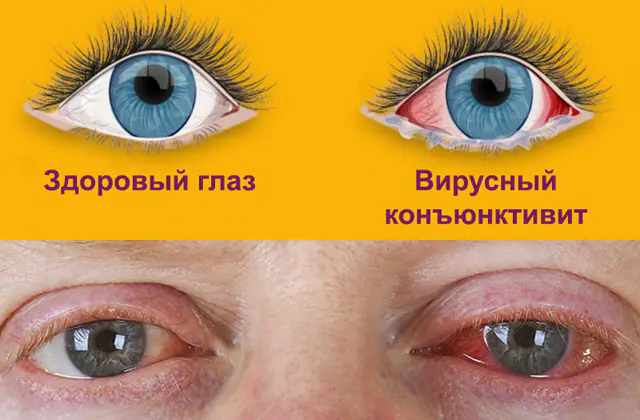
Description and causes of viral conjunctivitis in adults. Main symptoms and diagnosis. How to treat viral conjunctivitis - medications and folk remedies. Prevention.
The content of the article:- Reasons for development
- Symptoms and diagnosis
- Treatment options
- Medicines
- Folk remedies
- Prevention measures
Viral conjunctivitis is an acute infectious pathology of the conjunctiva, provoked by exposure to adenoviruses. It develops as an independent disease or against the background of the activation of another viral infection. The viral form is one of the most common ophthalmological pathologies.
Causes of viral conjunctivitis

The photo shows viral conjunctivitis in adults
Viral conjunctivitis of the eye is a common ophthalmic disease that is easy to catch. In most cases, the source of infection is a patient who has keratoconjunctivitis. Viral conjunctivitis is transmitted by airborne droplets and household contact.
The development of pharyngoconjunctival fever is caused by adenoviruses. The viral form of the disease can also be provoked by the following pathogens: herpes simplex virus, chicken pox, herpes zoster, measles. Viral conjunctivitis can also occur against the background of influenza, rubella, mumps, Coxsackie virus, and enterovirus.
In most patients, viral conjunctivitis develops against the background of a cold. It is accompanied by a sore throat and swollen lymph nodes.
The cause of viral conjunctivitis can be a hospital infection, which is transmitted by airborne droplets, as well as direct contact with a carrier of an acute form of the virus.
Important! One of the most severe complications of viral conjunctivitis is the development of “dry eye” syndrome, which occurs due to disturbances in the production of tear fluid. The cornea becomes cloudy, visual acuity decreases.Symptoms and diagnosis of viral conjunctivitis
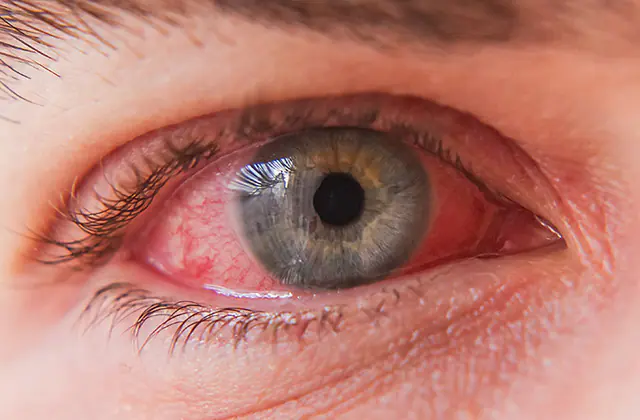
The disease has an acute onset and course. First it affects one eye, after 24-72 hours (in some cases up to 5 days) - the second.
The disease is preceded by close contact with a patient diagnosed with conjunctivitis or an acute viral infection. The incubation period for viral conjunctivitis is up to 3 weeks, after which the conjunctiva of one eye becomes swollen and watery discharge is observed. The organ of vision is irritated, the pathological process quickly spreads to the second eye.
Viral conjunctivitis is accompanied by redness of the eyes, lacrimation, blepharospasms, scanty mucous discharge, hemorrhages in the conjunctival area, and enlarged cervical or ear lymph nodes. Signs of viral conjunctivitis also manifest themselves in the form of decreased visual acuity.
The disease occurs in several stages with the following symptoms of viral conjunctivitis:
- The patient complains of a feeling of pain in the eyes, a sensation of a foreign body. The eyelids swell, and infiltrate accumulates in the lower anterior fold. The formation of small follicles, as well as pinpoint hemorrhages, is visible.
- The second stage develops a week after the exacerbation of the disease. There is an accumulation of pinpoint infiltrate under the epithelial tissues of the cornea, and visual acuity decreases. The parotid lymph nodes increase in size and become painful.
The duration of the pathological process is up to 1 month. This form of conjunctivitis occurs against the background of an exacerbation of an upper respiratory tract infection.
The follicular form of viral conjunctivitis is accompanied by the formation of follicles on the mucous membranes of the eyes. Adenoviral conjunctivitis is accompanied by sore throat, pharyngitis, and fever. A thin film forms on the surface of the eyes, after removal of which bleeding develops.
To make an accurate diagnosis, the patient’s complaints and clinical manifestations of the disease are taken into account. During the laboratory diagnosis of viral conjunctivitis, the technique of fluorescent antibody in conjunctival scraping (MFA) is used. To identify the type of viral infection, polymesic chain reaction (PCR diagnostics) is indicated. If necessary, additional immunological studies are used.
There is a simple test to distinguish viral conjunctivitis from allergic or bacterial. Pay attention to whether there is purulent discharge and what condition the lymph nodes are in. Discharge of pus and enlargement of the submandibular and ear nodes are an indication of the viral nature of the disease.
Methods for treating viral conjunctivitis
The decision on how to treat viral conjunctivitis is made by the doctor, taking into account the results of the examination, the patient’s age and accompanying symptoms. There is a basic treatment protocol recommended for all victims of viral conjunctivitis, and a list of additional medications. Treatment takes place in several stages. To prevent an intrahospital adenoviral epidemic, doctors examine the patient daily from the moment of admission to the hospital and implement sanitary and hygienic measures.
Medicines for viral conjunctivitis
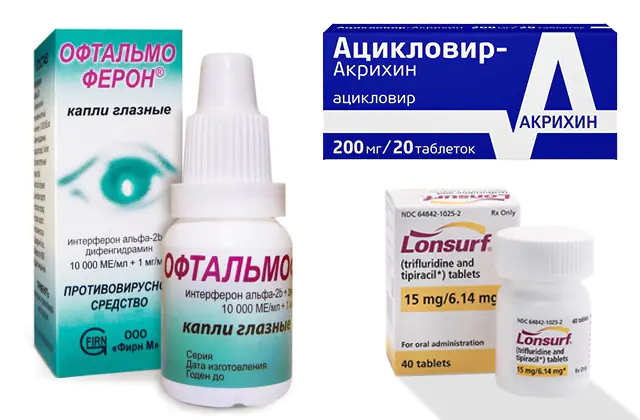
The basic medication recommended for patients with viral pathologies is Oftalmoferon. It is used throughout the entire period of treatment of viral conjunctivitis. This is a medication in the form of eye drops based on interferon, diphenhydramine and boric acid, which is prescribed to adults and children. The leading medicine among an extensive list of eye drops with antiviral properties.
Oftalmoferon exhibits the following pharmacological properties:
- immunomodulatory;
- anti-inflammatory;
- regenerating;
- local anesthetic.
Indicated for patients with adenoviral and enteroviral herpetic conjunctivitis. In acute cases of the disease, use 1-2 drops up to 8 times a day. As the inflammatory processes subside, the frequency of use is reduced to 3 times a day. Cost - 320 rubles. (130 UAH). The drug has no analogues.
The doctor also recommends the use of antiviral agents:
- Trifluridineis an expensive antiviral drug that is used for viral lesions of the organs of vision. The dosage, frequency and duration of use are determined strictly individually. Cost - 53,630 rubles. (21190 UAH) Analogues: Lonsurf.
- Acyclovirin the form of tablets for internal use, which is combined with ointment for viral conjunctivitis. Cost - 30-390 rubles. (12-150 UAH), depending on the manufacturer. Analogues: Zovirax, Herperax.
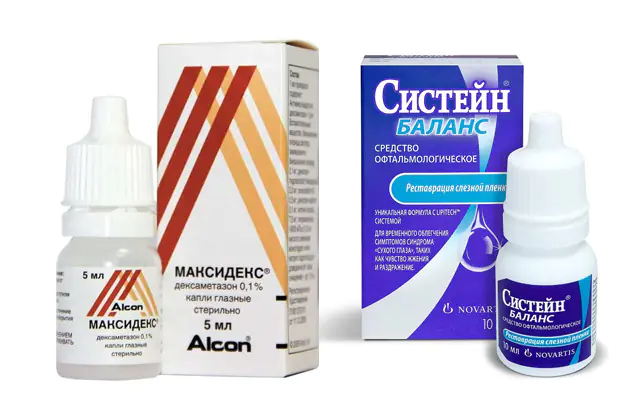
From the second week, anti-inflammatory and tear replacement therapy is added:
- Maxidex— eye drops for viral conjunctivitis from an American manufacturer with pronounced anti-inflammatory and desensitizing properties. Thanks to the active substance dexamethasone, the inflammatory process is actively suppressed, while there is no mineralocorticoid activity (the risk of negative systemic effects on the body is not manifested). The medicine is instilled 1-2 drops into each conjunctival sac every 4-7 hours. When using the medicine for more than 10 days, it is recommended to measure intraocular pressure. Price — 330 rub. (130 UAH). Analogs: Oftan Dexamethasone, Dexamethasone eye drops.
- Systain Balance- a product with a moisturizing effect that restores the lipid layer and prevents the rapid evaporation of tear fluid. These are oily drops that reduce the appearance of dry eye, discomfort and redness. Suitable for long-term use, up to several months. Cost - 600 rubles. (240 UAH). Analogs for pharmacological action: Oftagel, Optiv, Hilomax-Komod.
To eliminate rashes of corneal infiltrates, Vitabact is used - eye drops with antimicrobial and antiseptic effects. Allowed for patients from birth. Do not use if you are hypersensitive to the active substance - picloxidine. Price — 420 rub. (165 UAH). Analogue: Bactavit.
Folk remedies against viral conjunctivitis
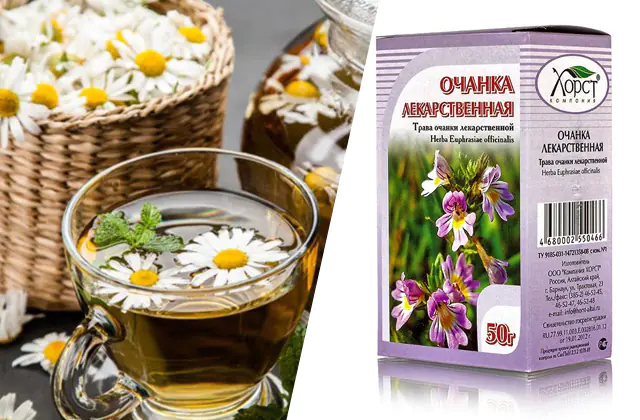
Traditional medicine reduces the severity of the inflammatory process and symptoms of the disease. They are used in addition to the basic treatment protocol.
Effective folk remedies for viral conjunctivitis:
- In the morning, it is recommended to wash your eyes with chamomile decoction. Pour boiling water over a few tablespoons of dried raw materials, leave for 60-90 minutes, and use as intended.
- For rinsing, they also use a soda solution (1 teaspoon of soda per 200 ml of water at room temperature). The procedure can be carried out in the morning and evening.
- To reduce swelling and redness of the eyes, use tea leaves. Cotton pads are generously moistened with tea leaves and applied to the eyes for 5-10 minutes. This procedure can be performed up to 6 times a day.
- The eyebright herb is poured with boiling water, boiled for 15 minutes, left for 60 minutes, and filtered. Moisten cotton pads with the resulting decoction and apply to the eyes for 15 minutes. To relieve the symptoms of viral conjunctivitis, the procedure can be performed up to 5 times a day. To enhance its effectiveness, eyebright is mixed with calendula, chamomile flowers, and celandine.
- Aloe juice is a universal remedy that is suitable for all forms of conjunctivitis. The leaves are cut, washed, and the juice is squeezed out. The resulting product is mixed with water and used to prepare compresses for the eyes. Installation duration is 20 minutes, frequency of installation is up to 6 times a day. Aloe juice can also be used as ophthalmic drops, 1-3 drops in each eye twice a day.
- To treat viral conjunctivitis, you can use freshly picked or dried tea rose inflorescences. 2 tablespoons of raw materials are poured with boiling water and left for 20 minutes. When the infusion has cooled, use it to wash the eyes and apply compresses. This remedy not only removes inflammation, but also has a rejuvenating effect.
- Violet flowers are mixed with celandine and cornflower inflorescences, poured with cool water, boiled in a water bath for 15 minutes, cooled, and filtered. The resulting product is used for eye compresses and internal administration. Use 1/3 cup twice a day for 2 weeks.
If traditional medicine is ineffective and the patient’s well-being worsens, stop therapy and seek advice from the attending physician.
Measures to prevent viral conjunctivitis

In order to prevent viral conjunctivitis, efforts are directed towards strengthening the immune status of the body: reviewing the diet, sleep hygiene, adherence to work and rest, hardening, moderate physical activity.
To prevent viral conjunctivitis, a number of recommendations are followed:
- use only their own cosmetics and towels;
- replace contact lenses with glasses;
- do not touch their eyes with dirty hands, a towel or napkins;
- wash their hands with soap before touching their eyes.
To reduce discomfort, you can use a compress based on tea leaves.
Viral conjunctivitis is contagious, so at the first signs of the disease it is recommended to seek advice from an experienced ophthalmologist. Independent selection of a treatment regimen is fraught with deterioration of the clinical picture, progression of the pathological process and the development of complications.
Video about the prevention and treatment of viral conjunctivitis:



